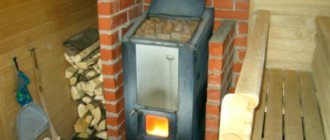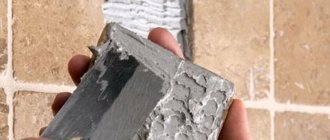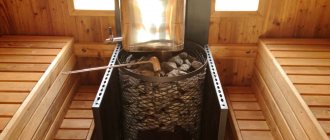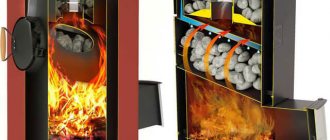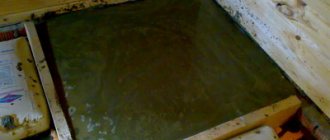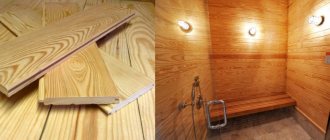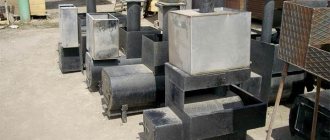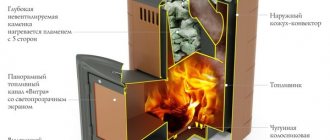Explaining to an experienced bathhouse attendant or an experienced steam lover why a stone mesh is needed on a bathhouse pipe is absolutely unnecessary. Anyone who has taken a steam bath at least once in their life knows how cruel and unforgiving a metal stove can be, especially a fire tube. This is a small section of metal chimney, only a meter long, connecting the flange of the furnace combustion chamber to the rest of the chimney duct.
A fire tube without a mesh with a stone heats the bathhouse too harshly
Purpose of the protective structure
The heater mesh on the pipe has another name - economizer.
The need to use such a design arises for a number of reasons:
- as smoke moves through the chimney, the heat coming from it is transferred to the pipe, as a result of which it begins to heat up and the air in the steam room dries out;
- thermal radiation can harm the skin of a bathhouse guest, and therefore it is better to reduce it.
To provide protection from unfavorable causes, it is necessary to cover the stove channel with a thin layer of pebbles. Ultimately, pipe overheating will be significantly reduced, thermal radiation will be softened, and heat accumulation will increase.
Specifically, the mesh for the pipe in the bathhouse will be the device where the pebbles should be placed. During the procedure, water is added to them and thus an additional amount of steam is obtained. The hot pebbles located around the chimney cool slowly and ultimately help the steam room dry out well.
Mistakes when installing a chimney in a bathhouse
- Assembly based on smoke, not condensation. The most common and common mistake that very quickly damages the pipe.
- Placement of wooden floors close to the pipes in the ceiling and walls. Savings on polyurethane foam.
- The use of materials that are strictly contraindicated for use as a smoke exhaust, since some of them can cause a fire.
- Insufficient chimney height.
- Grouping several chimney structures into one.
- Arbitrary calculation of the scale and diameter of materials.
Installing a chimney is a very serious process that requires the necessary skills, attentiveness, patience, and a responsible approach to studying information about various installation methods. If you strictly follow the manufacturers' instructions or the tips given in this article, you will definitely not make mistakes in the process.
Remember that chimney repairs often cost many times more than just installation services. It is for this reason that it is better to follow all the rules and recommendations at the bathhouse design stage.
Varieties
Any mesh is selected personally, taking into account consumer preferences, as well as the shape and size range of the stove itself.
The shape of the mesh can be rounded, square, cone-shaped, diamond-shaped or round. The mesh can be made in the form of a lattice or basket.
The length of the mesh is also calculated based on the dimensions of the chimney. The economizer can be the length of the entire chimney pipe, or maybe half or even a quarter.
The grid can have a certain design or can be made in the style of miniaturism. Manufacturers often make mesh from thick or thin rods, which are placed in the shape of a rhombus or square.
Tools and materials
During the production process, tools and equipment will be useful:
- welding inverter;
- angle grinder with a disk for stripping and cutting metal;
- sandpaper;
- electrodes;
- hand tool.
- Corner 40 cm - 4 pcs., length 28 cm - 8 pcs.;
- Rod or fittings 12-14 mm long 79 cm - 12 pcs., 28 cm long - 4 pcs.;
- Heat-resistant enamel, solvent, brush, rags.
See also How to attach wall cabinets to drywall
For welding you will need non-flammable clothing, a welder's mask, strong shoes and split leather leggings. For cleaning and painting - a respirator and protective gloves.
Criterias of choice
When choosing a design and material for mesh production, you should proceed from the following reasons:
Manufacturing instructions
The quality of the final product will directly depend on how painstakingly the preliminary work is carried out. These include the following operations:
- Open the blanks. Cut blanks from the rod and angle according to the given dimensions.
- Cleaning of rust and mechanical contamination from the welding area.
- Degreasing the welding area.
It would be better to clean all the workpieces in the preliminary step - this will save time when preparing for painting.
- weld short corners into two squares; the upper one is assembled with shelves inward, and the lower one - outward;
- attach vertical posts to the corners of the lower square (with the angle inward), they must be oriented strictly vertically, checking with a square; attach (at several points) the upper square to the upper ends of the vertical posts;
- mark the places where the rods are attached, 4 on each side of the square; grab the rods from the inside of the corners;
- at half the height, tie the vertical posts and rods with small blanks, they will play the role of stiffeners;
- make sure that all dimensions and angles of the structure match the design values; weld all seams one hundred percent;
- clean off slag and scale.
For places that are difficult to reach with an angle grinder, you should use sandpaper and sandpaper.
After completely cleaning the surfaces of the product, it must be degreased. White spirit, gasoline or other organic solvent is suitable for this. Now you can apply a layer of heat-resistant primer, and after it dries, a layer or two of heat-resistant enamel.
Important: If the chimney is already installed on the stove and there is no way to disassemble it, assembly will have to be carried out directly around the chimney pipe.
In this case, the workpieces will need to be completely cleaned before installation - then it will be impossible to get to the inside. During operation, the pipe must be protected from splashes of molten metal.
Limitations on the use of metal for a mesh frame
To make a mesh container you cannot use:
- Galvanized or painted wire, coated with PVC, polyester resins;
- Aluminum and bronze mesh wire meshes used in industrial chimneys and exhaust pipes as soot traps and spark arresters;
- Containers cannot be made from dissimilar materials that form galvanic couples, for example, aluminum-steel, copper-aluminium.
Such a mesh for pipes for stones made of non-ferrous metals quickly corrodes in the humid atmosphere of a steam room and often crumbles just before our eyes.
For a medium-sized sauna stove, you will need a mesh that can hold up to 20 liters of stone backfill. Since the stones used in the backfill are quite large, after placing the material in the mesh basket, an imbalance will inevitably arise, deflecting the container away from the chimney.
Therefore, the design must have at least two clamps that secure the mesh to the chimney. If small stone is used for backfilling, then the mesh should have a cell size of at least 10 mm. It is unsafe to use finer filler; the material produces very powerful steam, and sometimes the resulting fragments and screenings spill out through the mesh onto the floor of the steam room.
Selection of stones and their placement
Stones must be selected from diabase, soapstone or crimson quartzite. They not only have a beautiful appearance, but are also durable. Many people choose river pebbles for their heaters. In this case, you need to take into account that it must be a certain size. And before laying, be sure to wash all the stones.
The process of laying stones can be called throwing. You need to take four large stones of the same size and place them in four different directions around the pipe. This will make the product equidistant. Then the remaining stones can be thrown on top of these.
Over time, due to the effects of temperature, the mesh may become deformed, and the stones in it may sag. To prevent this from happening, you need to choose a calibrated stone or, in other words, so that it is equal in size to the width between the pipe and the product. It is also better to choose a round stone . This way it can form an even layer around the pipe. Small stones will help close the space between large stones.
See also How many meters of reinforcement are there in a ton
At first glance, a heater made by yourself may turn out to be inconspicuous, but you should not pay attention to this, because the main thing is not beauty, but benefit. Over time, you can transform it and it will last for many years.
Roof and ceiling passages
It is very important to treat with the utmost care and responsibility the places of passage through the ceilings of the bathhouse.
These areas are insulated, regardless of the type of chimney used, be it sandwich pipes or ordinary metal ones.
To ensure that passage through the ceilings is as safe and high quality as possible, a special box is used. You can either make it yourself or purchase it in a store.
During the installation process, the following should be taken into account:
- The diameter of the hole for the pipe should be much larger than the diameter of the pipe itself, since there should be a distance of 25-30 cm from the surface of the chimney to the ceiling structure;
- There should be no free space left around the pipe, since all of it must be tightly filled with insulation;
- The edges of the pipe connector should be treated with metal sheets before installing the box;
- Nearby wood elements must be treated with fire retardants.
DIY making
- one sheet of stainless steel; its remains, which may have remained after the manufacture of some devices in the steam room, are also suitable;
- mesh made of stainless wire, note that the cells should not be large so that the stones can be inside it and not fall out;
- several strips of steel to give the product rigidity and a beautiful appearance;
- aluminum rivets to secure the steel strips to the mesh.
Do not forget that galvanized material and iron cannot be used to make any bath products. At high temperatures, zinc can release toxic substances.
To secure the product to the chimney, it is necessary to make ears that can be easily tightened with bolts. With their help, the mesh can be put on the pipe after installing the stove.
It is worth considering that it is best to cover the entire part of the pipe with a mesh with stones. This will reduce harmful radiation from all exposed hot parts of the pipe. Thus, the microclimate in the bathhouse will become softer, and the steam room will remain warm for a long time. In addition, the life of the furnace will only be extended.
The work process is easy, and even a person who does not have the slightest experience can handle it.
Nets for stones from Teplodar and Vesuvius
Installation nuances
The mesh with stones weighs a lot; displacement of the structure can seriously damage the chimney pipe. Therefore, it needs to be securely fastened.
In the horizontal ribs of the lower square of the structure, you need to drill two holes for self-tapping screws. You will need to make matching holes in the top sheet of the sauna stove that are smaller in diameter than the self-tapping screw. The mesh is installed on the stove and attached to it with self-tapping screws. Next, the first section of the chimney pipe is lowered into it and connected to the outlet pipe. After installing all sections of the chimney, you can begin loading stones.
Don't just pile up rocks. There are certain rules for their layout. First you need to sort the stones by size. The largest stones are placed down, flat towards the stove. The next row is filled with smaller ones, laying them out with their flat side facing the chimney. So, gradually reducing the size, stones are added to the top of the grid. After the first heating, some shrinkage of the stones is possible. In this case, you can add the remaining ones on top.
The mesh for the heater allows you to place the stones so that they quickly warm up and effectively release heat. With this design you will get hot, soft, and aromatic steam. The stores offer a large number of different models, but a home craftsman can easily make the simplest one with his own hands.
Selection of stones and their placement
Stones must be selected from diabase, soapstone or crimson quartzite. They not only have a beautiful appearance, but are also durable. Many people choose river pebbles for their heaters. In this case, you need to take into account that it must be a certain size. And before laying, be sure to wash all the stones.
The process of laying stones can be called throwing. You need to take four large stones of the same size and place them in four different directions around the pipe. This will make the product equidistant. Then the remaining stones can be thrown on top of these.
See also Make a stove for the garage with your own hands
DIY stainless steel grate for sauna stove
Over time, due to the effects of temperature, the mesh may become deformed, and the stones in it may sag. To prevent this from happening, you need to choose a calibrated stone or, in other words, so that it is equal in size to the width between the pipe and the product. It is also better to choose a round stone . This way it can form an even layer around the pipe. Small stones will help close the space between large stones.
At first glance, a heater made by yourself may turn out to be inconspicuous, but you should not pay attention to this, because the main thing is not beauty, but benefit. Over time, you can transform it and it will last for many years.
Kinds
They are divided according to several characteristics:
- According to the configuration of the structures themselves, they can be round for installation on the chimney pipe. Rectangular or oval, repeating the configuration of the stove itself, when installing a mesh on top or completely covering the entire surface with stones;
- Based on performance materials. You might like a mesh made from twisted rods, all kinds of shapes made by a blacksmith, from which a beautiful container for the stone is assembled. A simple mesh can be made from steel rods and strips of sheet metal, or from a large cross-section pipe with cavities cut out in it for beauty and steam release;
- Heaters can be made of a closed type. In such devices, the stone is placed in a closed container, in which a door is made for storing and servicing the stones. This mesh allows you to keep heated, moist air in the steam room longer, but the temperature cannot be raised above 1000. The wood consumption for this design is higher than that of competitors;
- Open-type meshes accumulate less heat, but can easily heat the atmosphere of a steam room over 1000 and the wood consumption of such stoves is less. This design is carried out with the external laying of stone from the outside in a certain sequence; with its help, you can install a mesh both on the chimney pipe and on the stove body.
Advantages of a do-it-yourself mesh
First, you need to understand the difference between a factory mesh and a homemade one:
- the factory heater has the correct shape;
- beautiful and aesthetic appearance;
- rarely subject to deformation;
- different shapes and types.
But a homemade product has advantages:
- low cost of the finished product;
- the correct size for the pipe in the bathhouse;
- installation, design and dismantling are chosen by the bathhouse owner himself;
- performs all the same functions as the factory mesh and also does an excellent job.
Prices for mesh for stones vary, it all depends on the diameter, design and size. But I would like to note that a heater made by yourself will cost two or even three times less. Meshes from branded manufacturers are even more expensive, so it is best to devote time to this matter rather than overpay for the same design.
Purpose
The mesh heater has another name - economizer. Its main purpose is that when smoke flows through the chimney, its heat is transferred to the pipe and it becomes very hot, which leads to drying out the air in the bathhouse. In addition, thermal radiation can harm human skin and it will be better if it is reduced a little.
To protect the stove channel, it is necessary to cover it with a stone layer. This reduces pipe overheating. net will be an assistant in this .
You can use a mesh heater for any stove, but not one made of brick, because it has less inertia. Thanks to the mesh on the pipe made of carefully laid stones, a different atmosphere will be created in the bathhouse, it will protect the stove and the air in the steam room, as well as human health. The stove in the bathhouse takes on an original look, and your time will be pleasant and long, and those around you will be able to appreciate your work.
Sources:
https://bane.guru/aksessuary/setka-dlya-kamney-svoimi-rukami-dlya-truby-v-bane.html
What to choose, popular models
When choosing a specific model of stone mesh for the chimney, two conditions must be taken into account:
For example, if the stove is located against a wall or in a corner of the room, then the best option for a grate for stones on a pipe would be a semi-closed design with a blank rear part and slotted walls, photo.
If the chimney in the steam room is exhausted through the wall, a horizontal version of the mesh container will be required.
Most often, for chimney pipes of non-standard shape, the mesh for the stove in the bathhouse is made individually, to order or with your own hands. In addition, it will be necessary to provide additional fastening, since the strength of the chimney will clearly not be enough to hold a container with stones weighing 20-40 kg.
For a narrow and tall steam room, the mesh for stones on the chimney is made elongated, like a candle. This design is safer in tight spaces in the bathhouse.
Stone nozzles are made with perforated walls, in the form of rectangular and round containers.
Sometimes the container for the stone is designed in the form of a figured structure with forged rods. For cast iron stoves, it is allowed to install grids with a volume of no more than 35 liters, for steel structures - no more than 25 liters.
